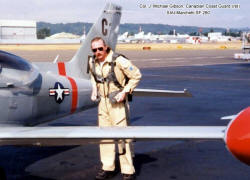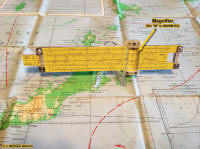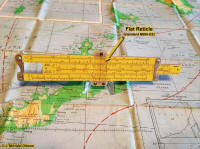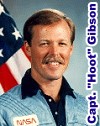 Which Slide Rule Really Went Aboard Apollo?...
Which Slide Rule Really Went Aboard Apollo?...
By Col. J. Michael Gibson, Canadian Coast Guard (ret)
While researching the history of a Hemmi student rule for a friend, I noticed several references to the Pickett N600-ES rule being taken aboard Apollo.
Since I've met a few of the Gemini / Apollo and STS astronauts over the years, I asked around, and it turns out that some cannot recall even taking a slide rule aboard, yet I continue to see claims that a Pickett N600-ES went to the moon five times.
I found it interesting that out of seven attempts, and six landings ... two missions elected not to take the 600.
But which ones?
The Smithsonian website shows a slide rule that was aboard A13, and also says that this item is "not currently on display ... it is either on loan, or in storage", so I called them to find out where it might be. After speaking at length with one of the staff, we also discovered a letter from Captain Lovell and Ken Mattingly, marked - record incomplete - and the photo with it shows a Pickett N600-ES rule with a style 4 logo, fitted with the convex cursor.
This strongly suggests the rule aboard A13 to be an early version of a Pickett N600-ES.
Yet I've also been told that the one that NASA actually used had a magnified cursor, and I've seen photos that also support this claim.
To be a pocket sized rule from Pickett, and have a magnified cursor it must be either the Pickett 600 M-T, or the M-ES.
The convex cursor puts the slide rule somewhere between 1962 -> 1975, when they began using this injection molded cursor instead of the flat cursor they used earlier. So the year is correct - however - the magnified cursor that Pickett used on two of their model 600's, produces nearly full resolution detail on a pocket size rule. This cursor was normally only seen on the full size N3 and N4 rules, but no serial number is listed for this cursor. Pickett stopped using serial numbers on the cursor bars when they changed from magnesium bars to nylon.
Admittedly, this magnified advantage would be quite convenient if you are attempting to save both space, and weight, and you really wanted the most accurate results.
The staff I've spoken with at both the Kennedy Space Center, and the curators at the Boeing Field Museum of Flight by Seattle, were unable to yield any further insight.
Just to provide you, however, with some additional context, I located a request Christopher C. Kraft Jr. made for 33 slide rules required for "Flight Crew-Ground Controller procedural utilization" during Mission AS-204.
I emailed one of the A7 crewmembers, and found that they had a circular slide rule with them, that they used for orbital calculations, yet there was no mention of a Pickett 600 being aboard.
I also emailed a crewmember aboard A12, and he does not recall taking a slide rule along.
I did locate a couple of photos of Dr. Buzz Aldrin with a slide rule, and they do appear to be Pickett slide rules. Photo numbered S66-62984 clearly shows a rule with stamped aluminum contoured posts, floating by Dr. Aldrin, and that would date the rule to the latter half of 1959 at the earliest, which would be in the correct date range. But it's aboard Gemini XII, not Apollo.
I spoke with a few of the historians at NASA, and together with some very helpful staff at the University of Houston-Clear Lake, we have reviewed nearly 2,100 pages of stowage lists for Apollo, and found that things were pretty ad-hoc, right up to A15. The crews could take items along in their personal kits and NASA really didn't pay too much attention. They were even able to keep some of the camera lenses they had used if they wanted.
A10's stowage list shows the slide rule as a "deleted item", and the reason listed was "crew preference", but there was one (1) aboard. A11, there is also one (1) slide rule listed, and the location simply states "on crew". A14 also lists one (1) aboard, also "on crew", and in each case, NASA lists them all as part number SEB33100047-302, but no style, model or company name.
Interesting that the stowage lists mention how many pens a crewmember has with him, yet no mention of who has the slide rule...
NASA stickers on the slide rule boxes also began appearing which claimed first 3, then 5 Moon missions. So it would seem that NASA missions really did use Pickett rules. The subtle inference was that whatever rule you were buying was the one, when in fact it was not.
The packaging also changed during this frenzy and the 600's began appearing with the Lunar Module emblazoned on the outside and inside cover of the box. The style 6 logo on these "Apollo rules" is the real stumbling block here, especially when compared to the rule sold by an auction house that stated it was the 'actual rule' that was aboard A11, and the Smithsonian photos showing the rule that was aboard A13.
Neither had the style 6 logo.
Since the NASA stickers were appearing on everything from $0.50 plastic pocket rules to the high end ones, there's no real clue there. And we know that Pickett really pushed the 6" pocket rule as a unique product to them.
The rule the auction house sold for $77,675.00 on September 21, 2007, was accompanied by a letter from Dr. Aldrin attesting to it's authenticity. That rule has;
- stamped aluminum posts, with a symmetrical contour
- nylon cursor bars - a grooved convex lens
- the photo also shows a grooved slide
- it bears a Style 5 logo (which was used by Pickett from 1962 -> 1964)
- the convex lens shown in the photo was used from 1960 -> 1975
This rule would be at least five years old by the time it went along with Dr. Aldrin, and is from his "personal collection" -- according to the letter that accompanied it. The one aboard A13 was even older, as the style 4 logo was used from 1958 -> 1962.
Now we have two cursors, and a style 4, 5 and 6 logo to choose from.
I located some photos of the labels Pickett glued to the end of their packing boxes that were emblazoned with the Lunar Module, trumpeting the claim that they were aboard 5 Moon missions, and 5 Apollo missions. The problem here is, they also made this claim on a 1968 product catalog - and the first Lunar mission was not until December of '68.
You would expect a new product catalog to be disseminated in January. Not December.
They also packaged four different types of rules in these boxes, and suddenly claimed the rule had 22 scales, instead of 19, yet no new scales were added - they just counted them differently. If you count the LL scales as one, you get 19. However, the LL scales are actually LL- and LL+, which of course, would be two. Count them that way, and the same rule suddenly has 22 scales instead of 19.
Pickett is busy packaging these rules with their style 6 logo, and gluing labels to the boxes on all but the 600-ES versions, claiming this was the one that was carried aboard 5 Apollo missions, yet both the 600 M - ES, and the 600-ES versions were being sold in these boxes, and the Apollo program is winding down.
Apollo 16 is launching on April 16, 1972.
The retail price of the ES version was about $10.95, and the M - ES was about $5.00 more, and sometimes slide rules were mislabelled. Or even misrepresented by the number of scales it had.
Pickett Industries now moves to Nogales Mexico in 1974….
Chartpak Inc, the company that Pickett Industries was sold to in 1985, have not carried slide rules in years, and subsequently sold to Chroma in NY, and as it turns out, Chroma disbanded their drafting department around 2014 / 15, so there are no records there either.
So which slide rule really went aboard Apollo?
It seems likely there were three (3), and NASA, in its typical fashion, by not recording the specific type that was used, prevented any one company from getting all the attention. After all, if you've used one of these instruments, you probably have your favorite, and if your life is depending on the result - having an old, trusted friend with you would be a nice feeling.

 Shown here (left) is my Pickett N600 M -
ES, and you can clearly see how much magnification this style of cursor provided.
Shown here (left) is my Pickett N600 M -
ES, and you can clearly see how much magnification this style of cursor provided.
My other Pickett N600 ES (right) is equipped with the standard cursor, and is only slightly convex.
If you look closely at both of these photos, you can see the LL- and LL+ scales, the style 6 logo, and the cursor bars with hooked, as well as symmetrical curves. All significant details needed to date the rule. Both of these rules could easily have been the same as the ones carried aboard Apollo.

 "
"


